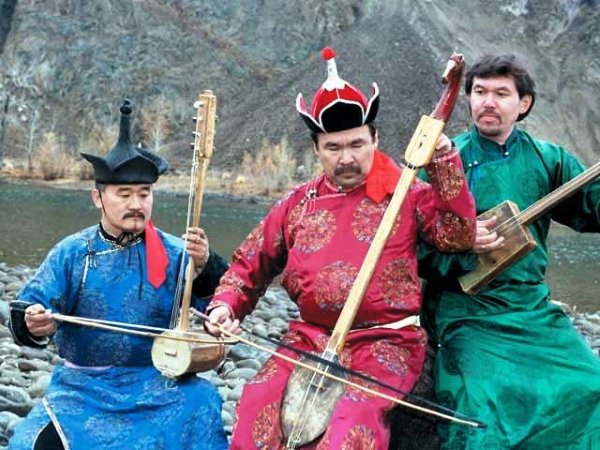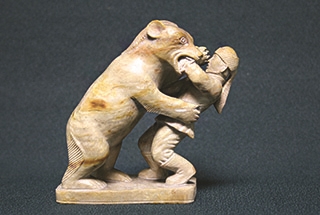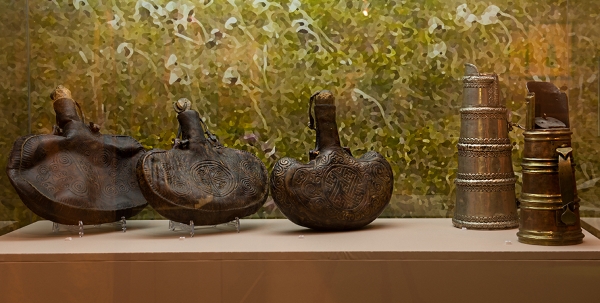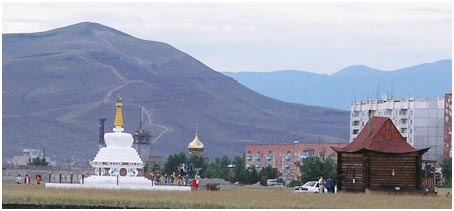
I first got to know Tuva not through sight, touch or smell but rather by hearing. Although in my semi-conscious childhood, when I collected post stamps, I remember coming across strange, rhomb-shaped stamps reading “Touva”.
At the Perm ethnic festival Kamwa, in the full house of the opera and ballet theatre, the famous Tuvan choral group of throat singing “Huun-Huur-Tu” was performing and the ancient hall covered with gilt was suddenly filled with the voice of “wild” Asia, where people discerned the howling of the wind in boundless steppes of South Siberia and the roar of mountain streams, the ends of them following as two impetuous tributaries (Biy-Khem and Kaa-Khem) into the great river Yenissei, and “voices” of freely grazing herds and flocks… The magic of singing cast its spell not only on those present. One of the group’s participants told later that during their tour of the United States, great Frank Sinatra invited them to his villa and they had to spend there more time than they expected. Sinatra asked Tuvans to sing again and again and repeated: “I cannot sing in this way…”
Indeed, for Europeans and Americans trained in the classical tradition of sound extraction it’s next to impossible to fathom the vocal secrets of those who have literally got used to not opening their mouths wide. The perpetual nomads of Tuva never speak unnecessary words, given the fierce winds and sand storms in their steppes…
The gallery of Tuvan glory

Even if you ask a casual passer-by he would tell you that Tuva is a very far-off land. But if you ask a geography-savvy person she would explain that Tuva lies in the very heart of Asia, which is visibly confirmed by the obelisk stationed in this area. And the experienced researcher would illumine that this land reminds of a huge cauldron, surrounded on all sides by mountain ridges of different height. Translated from the scientific, this means: “No way to pass for a walker, driver or pilot”. This remains largely true: Tuva still lacks railways and one can only get there over the only federal route M54 or by plane, though the airport is very small in Kyzyl.
Today Tuva can be visited in several halls of the All-Russian Museum of Decorative, Applied and Folk Art. The republic has never made its appearance in Moscow in the form of such a detailed composition. The exhibition “Tuva in the flight of time”, as is the custom, is timed to the grand jubilee date – 100 years ago on April 17, 1914, Tuva (officially named Tyva nowadays), then under the name of Uryankhaisky krai of the Yenissei Governorate, accepted the protectorate of the Russian Empire. There is also a minor jubilee: 85 years ago the Aldan Maadyr Museum was founded in the Republic of Tyva. Nevertheless, Viktor Chigzhit has frequented Moscow of late: in June he opened the exhibition of Nadya Rusheva (Tuvan on her mother’s side) and now a greater part of her heritage is kept in this museum.
Rusheva is a well-known persona. Other people who are the glory of Tuva are not so well-known and so the exhibition opens with a sort of Tuvan “Hall of Fame”. Places of honor there are taken by such persons as Mongush Buyan-Badargy (1892-1932), the founder of Tuvan statehood, and Chamzy Ondar Lopsan (1857-1930) who was the spiritual leader of Tuvans for many years. In spite of the fact that Tuva (People’s Republic of Tannu-Tuva) was formally an independent (in fact, buffer) state, both men were executed by local chekists.
Among the other celebrities is wonderful Tuvan actor Maxim Munzuk (1910-1999) who starred as Dersu Uzala in the famous film of Akira Kurosawa – valorous cavalryman, Hero of the Soviet Union Tulush Kechil-ool (1919-1945). For some reason we do not see in this pantheon the legendary general of Genghiz Khan and Batu, Subudey-bagatur, who came form Uryankhaisky Land… On the other hand, we see in the Hall of Fame well-known scholars who did not have any Tuvan blood running in their veins: Vladimir Yermolaev (1892-1982) who devoted almost half a century to the National Museum of Tuva, and Sevyan Vainshtein who also developed a passion for this magnetic land in his youth.
Be careful with the “aragy”…

Their finds constitute a large part of the exhibition built on the full day principle: morning-afternoon-evening-night… The lovers of pungent museum emotions have almost nothing to relish on: seemingly routine objects of nomadic household (and Tuvans are still nomads today). Some may like a horse harness, others – typically tall Tuvan hats, still others – clay flasks, different in size, shape and ornament, called “kogeerzhik” in Tuvan.
They are normally utilized as vodka containers. The local brand of vodka named “aragy” is prepared from… milk. They use special hooch still called “shuuruun”, usually made of whole wood trunk after the core is removed. After the first distillation the drink having a strong milk smell contains little alcohol (usually not more than 13%), but you should better be careful, as with the Japanese sake: your mind can be sober, but your legs… Tuvans will tell you a story of the first Russian President who drank too much of this national beverage.
“The local cuisine does not go on tours,” as a French saying goes, and this is doubly true in respect of Tuvan cuisine. There is a legend that on one occasion the Persian king made a captive Spartan prepare a famous broth for him from bull’s blood, lentils and salt – disgusting to taste, but rarely fattening. “Now I understand why you are such excellent warriors – it’s easier to die than to eat this shit!” said the king. “In order to cook this broth, one has to bathe in Eurotas (a river in Sparta) first,” answered the Spartan. The same is true about the Tuvan cuisine: to appreciate arzhy (dry curds), kurut (dried young cheese) and boorzak (deep fried pieces of dough – somewhat resembles the Tartar chak-chak, but contains much less sugar), you need to be a nomad somewhere in the foothills of the Western Sayany or Altai mountains.
Steam engine in Tuvan steppes

It is good and convenient to roam in the daytime. And what will you do in the evening and during long-long nights, when beyond the threshold of the yurt securely covered with skins the frost is minus 40? For instance, transforming any prosaic-utilitarian thing like a cradle hook (a lot of them are on display at the exhibition) into an object of art, or carving toys for kids out of wood which is a scanty resource in the local steppes. Tuva is famous for a very soft stone called agalmatolite, or wax stone, or soap rock. It may have different color shades, but the one found in Tuva is white or yellowish. And it shines from within like selenite, now vanishing in the Urals.
“You’ll become a stone carver here against your will,” I was told at the opening ceremony of the exhibition by Kombu D. Bizhek, an old craftsman, also known in Tuva as ethnographer and writer. “And our craftsmen never studied at any art schools or academies!” Small agalmatolite figurines reveal all facets of Tuvan everyday life which is now threatened and red-listed. The point is that talks about laying a railroad to Kyzyl began long ago. It will certainly facilitate communication with the remote land, but it’s frightful to think of what may happen to numerous established camping grounds after rails transverse this territory. The experience of European parts of Russia is rather telling: once upon a time local authorities did their best to divert a railroad from Suzdal, Borovsk, Pereslavl and other places. The lack of railway communication actually benefitted those towns and helped preserving their historic image and way of life, on one hand. But on the other hand, where can you hide from progress? Not even in Trans-Baikal steppes!
The exhibition will last until November 30.
Georgy Osipov

 I first got to know Tuva not through sight, touch or smell but rather by hearing. Although in my semi-conscious childhood, when I collected post stamps, I remember coming across strange, rhomb-shaped stamps reading “Touva”.
I first got to know Tuva not through sight, touch or smell but rather by hearing. Although in my semi-conscious childhood, when I collected post stamps, I remember coming across strange, rhomb-shaped stamps reading “Touva”.  Even if you ask a casual passer-by he would tell you that Tuva is a very far-off land. But if you ask a geography-savvy person she would explain that Tuva lies in the very heart of Asia, which is visibly confirmed by the obelisk stationed in this area. And the experienced researcher would illumine that this land reminds of a huge cauldron, surrounded on all sides by mountain ridges of different height. Translated from the scientific, this means: “No way to pass for a walker, driver or pilot”. This remains largely true: Tuva still lacks railways and one can only get there over the only federal route M54 or by plane, though the airport is very small in Kyzyl.
Even if you ask a casual passer-by he would tell you that Tuva is a very far-off land. But if you ask a geography-savvy person she would explain that Tuva lies in the very heart of Asia, which is visibly confirmed by the obelisk stationed in this area. And the experienced researcher would illumine that this land reminds of a huge cauldron, surrounded on all sides by mountain ridges of different height. Translated from the scientific, this means: “No way to pass for a walker, driver or pilot”. This remains largely true: Tuva still lacks railways and one can only get there over the only federal route M54 or by plane, though the airport is very small in Kyzyl. Their finds constitute a large part of the exhibition built on the full day principle: morning-afternoon-evening-night… The lovers of pungent museum emotions have almost nothing to relish on: seemingly routine objects of nomadic household (and Tuvans are still nomads today). Some may like a horse harness, others – typically tall Tuvan hats, still others – clay flasks, different in size, shape and ornament, called “kogeerzhik” in Tuvan.
Their finds constitute a large part of the exhibition built on the full day principle: morning-afternoon-evening-night… The lovers of pungent museum emotions have almost nothing to relish on: seemingly routine objects of nomadic household (and Tuvans are still nomads today). Some may like a horse harness, others – typically tall Tuvan hats, still others – clay flasks, different in size, shape and ornament, called “kogeerzhik” in Tuvan. It is good and convenient to roam in the daytime. And what will you do in the evening and during long-long nights, when beyond the threshold of the yurt securely covered with skins the frost is minus 40? For instance, transforming any prosaic-utilitarian thing like a cradle hook (a lot of them are on display at the exhibition) into an object of art, or carving toys for kids out of wood which is a scanty resource in the local steppes. Tuva is famous for a very soft stone called agalmatolite, or wax stone, or soap rock. It may have different color shades, but the one found in Tuva is white or yellowish. And it shines from within like selenite, now vanishing in the Urals.
It is good and convenient to roam in the daytime. And what will you do in the evening and during long-long nights, when beyond the threshold of the yurt securely covered with skins the frost is minus 40? For instance, transforming any prosaic-utilitarian thing like a cradle hook (a lot of them are on display at the exhibition) into an object of art, or carving toys for kids out of wood which is a scanty resource in the local steppes. Tuva is famous for a very soft stone called agalmatolite, or wax stone, or soap rock. It may have different color shades, but the one found in Tuva is white or yellowish. And it shines from within like selenite, now vanishing in the Urals.





